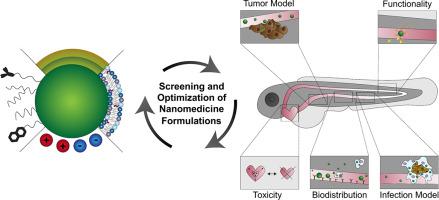Advanced Drug Delivery Reviews ( IF 15.2 ) Pub Date : 2019-01-04 , DOI: 10.1016/j.addr.2019.01.001 Sandro Sieber , Philip Grossen , Jeroen Bussmann , Frederick Campbell , Alexander Kros , Dominik Witzigmann , Jörg Huwyler

|
The interactions of nanomedicines with biological environments is heavily influenced by their physicochemical properties. Formulation design and optimization are therefore key steps towards successful nanomedicine development. Unfortunately, detailed assessment of nanomedicine formulations, at a macromolecular level, in rodents is severely limited by the restricted imaging possibilities within these animals. Moreover, rodent in vivo studies are time consuming and expensive, limiting the number of formulations that can be practically assessed in any one study. Consequently, screening and optimisation of nanomedicine formulations is most commonly performed in surrogate biological model systems, such as human-derived cell cultures. However, despite the time and cost advantages of classical in vitro models, these artificial systems fail to reflect and mimic the complex biological situation a nanomedicine will encounter in vivo. This has acutely hampered the selection of potentially successful nanomedicines for subsequent rodent in vivo studies. Recently, zebrafish have emerged as a promising in vivo model, within nanomedicine development pipelines, by offering opportunities to quickly screen nanomedicines under in vivo conditions and in a cost-effective manner so as to bridge the current gap between in vitro and rodent studies. In this review, we outline several advantageous features of the zebrafish model, such as biological conservation, imaging modalities, availability of genetic tools and disease models, as well as their various applications in nanomedicine development. Critical experimental parameters are discussed and the most beneficial applications of the zebrafish model, in the context of nanomedicine development, are highlighted.
中文翻译:

斑马鱼作为纳米药物的临床前体内筛选模型
纳米药物与生物环境的相互作用在很大程度上受到其理化性质的影响。因此,配方设计和优化是成功开发纳米药物的关键步骤。不幸的是,由于这些动物体内成像受限,严重限制了啮齿动物中大分子纳米药物制剂的详细评估。此外,啮齿动物的体内研究既费时又昂贵,限制了在任何一项研究中可以实际评估的制剂数量。因此,纳米药物制剂的筛选和优化是最常见的替代生物模型系统,例如人源细胞培养。然而,尽管经典体外疗法具有时间和成本优势在这些模型中,这些人工系统无法反映和模仿纳米药物在体内会遇到的复杂生物学情况。这严重地阻碍了用于随后的啮齿动物体内研究的潜在成功的纳米药物的选择。近年来,斑马鱼已经成为一种有希望的体内模型,在纳米药物的开发过程中,它提供了在体内条件下以经济有效的方式快速筛选纳米药物的机会,从而弥合了目前的体外差异。和啮齿动物研究。在这篇综述中,我们概述了斑马鱼模型的几个有利特征,例如生物保护,成像方式,遗传工具和疾病模型的可用性以及它们在纳米医学发展中的各种应用。讨论了关键的实验参数,并突出了斑马鱼模型在纳米医学发展中的最有益应用。











































 京公网安备 11010802027423号
京公网安备 11010802027423号